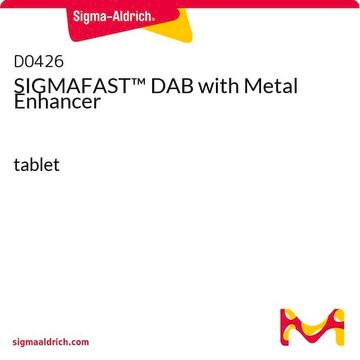D9015
3,3′-Diaminobenzidine tetrahydrochloride hydrate
≥96% purity (TLC), powder
About This Item
Polecane produkty
product name
3,3′-Diaminobenzidine tetrahydrochloride hydrate, ISOPAC®
Poziom jakości
Próba
≥96% (TLC)
Postać
powder
kolor
off-white to faint red, to beige
mp
280 °C
rozpuszczalność
water: 50 mg/mL, clear to slightly hazy
Zastosowanie
diagnostic assay manufacturing
hematology
histology
temp. przechowywania
room temp
ciąg SMILES
O.Cl.Cl.Cl.Cl.Nc1ccc(cc1N)-c2ccc(N)c(N)c2
InChI
1S/C12H14N4.4ClH.H2O/c13-9-3-1-7(5-11(9)15)8-2-4-10(14)12(16)6-8;;;;;/h1-6H,13-16H2;4*1H;1H2
Klucz InChI
DXWSCXIZIHILNP-UHFFFAOYSA-N
Szukasz podobnych produktów? Odwiedź Przewodnik dotyczący porównywania produktów
Powiązane kategorie
Zastosowanie
Działania biochem./fizjol.
Opakowanie
Przestroga
Rekonstytucja
Informacje prawne
ISOPAC
Hasło ostrzegawcze
Danger
Zwroty wskazujące rodzaj zagrożenia
Zwroty wskazujące środki ostrożności
Klasyfikacja zagrożeń
Acute Tox. 4 Oral - Carc. 1B - Eye Irrit. 2 - Muta. 2
Kod klasy składowania
6.1C - Combustible acute toxic Cat.3 / toxic compounds or compounds which causing chronic effects
Klasa zagrożenia wodnego (WGK)
WGK 3
Temperatura zapłonu (°F)
Not applicable
Temperatura zapłonu (°C)
Not applicable
Środki ochrony indywidualnej
Eyeshields, Gloves, type N95 (US)
Choose from one of the most recent versions:
Masz już ten produkt?
Dokumenty związane z niedawno zakupionymi produktami zostały zamieszczone w Bibliotece dokumentów.
Klienci oglądali również te produkty
Produkty
NBT-BCIP substrate system aids in western blotting and immunohistological staining, producing a blue-purple insoluble end product.
Nasz zespół naukowców ma doświadczenie we wszystkich obszarach badań, w tym w naukach przyrodniczych, materiałoznawstwie, syntezie chemicznej, chromatografii, analityce i wielu innych dziedzinach.
Skontaktuj się z zespołem ds. pomocy technicznej










